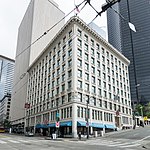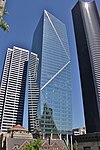4/C
Emporis template using building IDProposed skyscrapers in the United StatesResidential skyscrapers in SeattleSkyscraper hotels in SeattleSkyscraper office buildings in Seattle
4/C, also known as 701 Fourth Avenue and 4th & Columbia, is a proposed supertall skyscraper in Seattle, Washington. If built, the 1,029-foot-tall (314 m), 93-story mixed-use tower will be the tallest in Seattle, surpassing the neighboring Columbia Center. It would also be the Pacific Northwest's first supertall building, with a height of over 1,000 feet. It is being developed by Miami-based Crescent Heights and designed by LMN Architects, with a total of 1.2 million square feet (110,000 m2) in gross leasable area split between 1,200 apartments, 150 hotel rooms, office space and retail.
Excerpt from the Wikipedia article 4/C (License: CC BY-SA 3.0, Authors).4/C
4th Avenue, Seattle First Hill
Geographical coordinates (GPS) Address Nearby Places Show on map
Geographical coordinates (GPS)
| Latitude | Longitude |
|---|---|
| N 47.6040184 ° | E -122.3314913 ° |
Address
4th Avenue 701
98104 Seattle, First Hill
Washington, United States
Open on Google Maps











